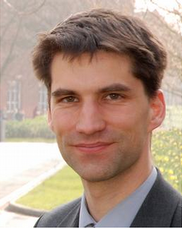
Hans Fangohr
- Head of Computational Modelling Group (Website)
- Director Centre for Doctoral Training in Next Generation Computational Modelling (Website)
- Co-Director Doctoral Training Centre for Complex Systems Simulations (Website)
- Position
- Professor
- Institution
- Engineering Sciences (FEE)
- Webpage
- http://www.soton.ac.uk/~fangohr
- Telephone
- 023 80598345
- fangohr@soton.ac.uk
- Fax
- 023 80594813
- https://twitter.com/ProfCompMod
- Contact
- Complete this online contact form to contact Hans.
Research in Computational Methods
Hans is a Professor of Computational Modelling at the University of Southampton, and head of this Computational Modelling Group, director of the EPSRC Centre for Doctoral Training in Next Generation Computational Modelling, and co-director of the Institute and EPSRC Doctoral Training Centre for Complex Systems Simulations.
He received his undergraduate degree "Diplomphysiker" in physics from the University of Hamburg (Germany) and completed his PhD studies in High Performance Computing in the department of Electronics and Computer Science at the University of Southampton.
His research interests are computer simulation methodology and applied computer simulation, in particular the application of computational modelling to physical and engineering processes and materials, to underpin, support and direct experimental and design work in academia and industry.
His interests in Computational Modelling methodology include the development of algorithm and numerical methods, efficient exploitation of existing and emerging infrastructure for massive numerical computations, effective analysis of simulation results and software engineering for research codes, and uptake and further development of tools and techniques that foster rigour and reproducibility in computational science.
Within these areas, he is working with particle simulations - such as Molecular Dynamics and Monte-Carlo methods - and finite difference and finite element schemes. He is also interested in multi-scale and multi-physics simulations, with emphasis on nanoscale systems and devices.
Current research projects include micromagnetic modelling, distributed data archives, astrophysical simulations, the simulation of the vortex state in layered superconductors and adatom dynamics on surfaces. Several projects are being performed in close collaboration with experimental groups characterising and fabricating materials that Hans' group is investigating numerically. The group has developed the nmag simulation package and a number of other open source tools, which are used by researchers in academia and industry across the globe.
Hans is passionate about teaching, and delivers training in computational modelling to undergraduate and postgraduate students in the Faculty of Engineering and the Environment and the Centre for Doctoral Training in Next Generation Computational Modelling, which includes numerical analysis and simulations methods, programming on different levels, and software development for simulation work in research and development.
He researches learning and teaching methods appropriate to education in computational science, and has been awarded the Deputy Vice Chancellor's Teaching Award in 2006, 2010 and 2013 for his innovative redesign of the engineering computing curriculum, the introduction of the Elevator Pitch presentations for Group design projects, and the introduction of automatic and instant feedback provision for computer codes developed by the students. His lectures are rated highly by the students.
Publications
Are available at http://www.southampton.ac.uk/~fangohr/publications.
See also
More information is available on Hans Fangohr's personal website .
Hans's team members
 Richard Boardman Richard BoardmanSenior Research Fellow, Engineering Sciences (FEE) |
 Aleksander Dubas Aleksander DubasResearch Fellow, Engineering Sciences (FEE) |
 Thomas Kluyver Thomas KluyverResearch Fellow, Engineering Sciences (FEE) |
 Ben Schumann Ben SchumannPostgraduate Research Student, Engineering Sciences (FEE) |
 Maximilian Albert Maximilian AlbertPostgraduate Research Student, Engineering Sciences (FEE) |
 Rebecca Carey Rebecca CareyPostgraduate Research Student, Engineering Sciences (FEE) |
 Valerio Vitale Valerio VitalePostgraduate Research Student, Electronics and Computer Science (FPAS) |
 Ryan Pepper Ryan PepperPostgraduate Research Student, Engineering Sciences (FEE) |
 James Snowdon James SnowdonPostgraduate Research Student, Civil Engineering & the Environment (FEE) |
 Lucy Upton Lucy UptonPostgraduate Research Student, Engineering Sciences (FEE) |
 Alejandra Vergara Lope Alejandra Vergara LopePostgraduate Research Student, Engineering Sciences (FEE) |
 Dmitri Chernyshenko Dmitri ChernyshenkoPostgraduate Research Student, Engineering Sciences (FEE) |
 Mukarramah Yusuf Mukarramah YusufPostgraduate Research Student, Civil Engineering & the Environment (FEE) |
 Elena Vataga Elena VatagaTechnical Staff, iSolutions |
 Susanne Ufermann Fangohr Susanne Ufermann FangohrAdministrative Staff, Civil Engineering & the Environment (FEE) |
 Petrina Butler Petrina ButlerAdministrative Staff, Research and Innovation Services |
 Massoud Najafi Massoud NajafiAlumnus, Arbeitsbereich Technische Informatik Systeme, University of Hamburg, Germany |
 Vince Coleman Vince ColemanAlumnus, |
 Weiwei Wang Weiwei WangAlumnus, Ningbo University |
 Dan Mason Dan MasonAlumnus, University of Southampton |
 Stuart Curtis Stuart CurtisAlumnus, University of Southampton |
 Matteo Franchin Matteo FranchinAlumnus, Engineering Sciences (FEE) |
 Andreas Knittel Andreas KnittelAlumnus, Industry |
 Marijan Beg Marijan BegExternal Member, Imperial College London |
 Mark Vousden Mark VousdenExternal Member, University of Southampton |
Joint projects with...
 Atul Bhaskar Atul BhaskarSenior Lecturer, Engineering Sciences (FEE) |
 Neil Bressloff Neil BressloffProfessor, Engineering Sciences (FEE) |
 Seth Bullock Seth BullockProfessor, Electronics and Computer Science (FPAS) |
 Kees de Groot Kees de GrootProfessor, Electronics and Computer Science (FPAS) |
 Peter de_Groot Peter de_GrootAlumnus, Physics & Astronomy (FPAS) |
 Jonathan Essex Jonathan EssexProfessor, Chemistry (FNES) |
 Thomas Fischbacher Thomas FischbacherAlumnus, Engineering Sciences (FEE) |
 Ian Hawke Ian HawkeLecturer, Mathematics (FSHS) |
 Peter Horak Peter HorakReader, Optoelectronics Research Centre |
 James Scanlan James ScanlanProfessor, Engineering Sciences (FEE) |
 Suleiman Sharkh Suleiman SharkhProfessor, Engineering Sciences (FEE) |
 Chris-Kriton Skylaris Chris-Kriton SkylarisLecturer, Chemistry (FNES) |
 Kenji Takeda Kenji TakedaAlumnus, Engineering Sciences (FEE) |
 Weiwei Wang Weiwei WangAlumnus, Ningbo University |
 Ben Waterson Ben WatersonLecturer, Civil Engineering & the Environment (FEE) |
Research Groups
Computational Engineering and Design Group (CED)
Engineering Sciences (FEE)
Institute for Complex Systems Simulations (ICSS)
University of Southampton
Projects

An investigation in to the effects of information provision on driver learning
With Ben Waterson (Investigator), James Snowdon

Centre for Doctoral Training in Next Generation Computational Modelling
With Ian Hawke, Peter Horak (Investigators), Susanne Ufermann Fangohr, Thorsten Wittemeier, Kieran Selvon, Alvaro Perez-Diaz, David Lusher, Ashley Setter, Emanuele Zappia, Hossam Ragheb, Ryan Pepper, Stephen Gow, Jan Kamenik, Paul Chambers, Robert Entwistle, Rory Brown, Joshua Greenhalgh, James Harrison, Jonathon Waters, Ioannis Begleris, Craig Rafter

Complex Systems Simulations Centre for Doctoral Training
With Jonathan Essex, Seth Bullock (Investigators)

Complexity in Modelling Electric Marine Propulsive Devices
With Suleiman Sharkh, Neil Bressloff (Investigators), Aleksander Dubas

Generic Operational Simulation of Civil Unmanned Air Vehicle Operations
With James Scanlan (Investigator)

Magnon-Driven Domain-Wall Dynamics in the presence of Dzyaloshinskii-Moriya Interaction
With Weiwei Wang

Modelling micromagnetism at elevated temperature
With Kees de Groot, Peter de_Groot (Investigators), Dmitri Chernyshenko

Nmag - computational micromagnetics
With Thomas Fischbacher (Investigator), Matteo Franchin, Andreas Knittel, Maximilian Albert, Dmitri Chernyshenko, Massoud Najafi, Richard Boardman

Operational Simulation of the Solent Search-and-Rescue environment
With James Scanlan, Kenji Takeda (Investigators), Ben Schumann

Vibrational spectroscopy from ab initio molecular dynamics
With Chris-Kriton Skylaris (Investigator), Valerio Vitale
Gallery

Schematic represenation of thermally assisted writing process on patterned media. Spot 1 is heated for 1 nano second (to 800K), then spot 2 is heated (instantaneously) to 800K. The colourmap shows the diffusion of temperature in the material. The last plot shows isosurfaces, i.e. layers of constant temperature in the material. The spacing of the iso surfaces is 50K.


















